NIX: Una lampada coi fiocchi by Mattia Anderle
Exploring the crystallization of snowflake geometrical formations, this research project delves into the captivating beauty of nature's patterns.
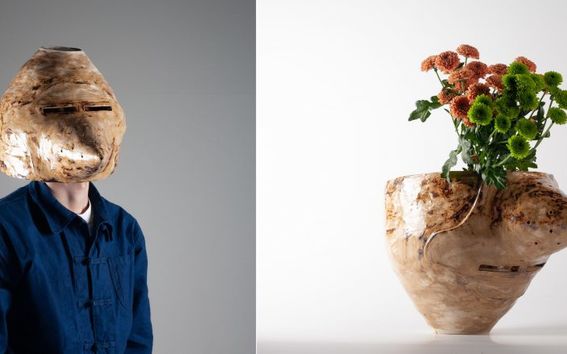
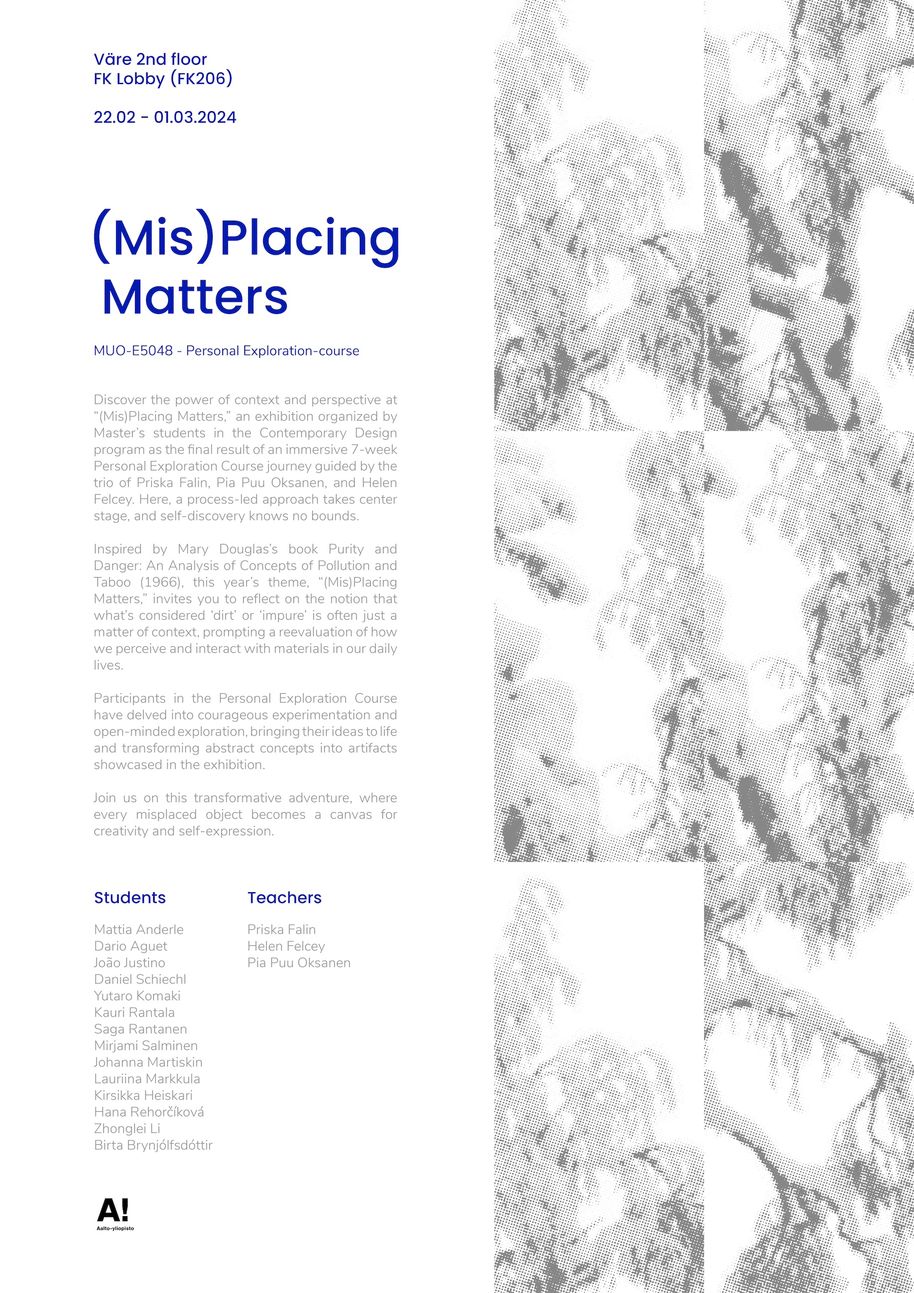
Exploring the crystallization of snowflake geometrical formations, this research project delves into the captivating beauty of nature's patterns.
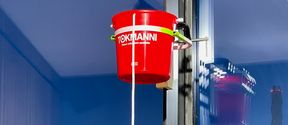
The work is a celebration of the whimsical and joyous sides of Finland as seen through the eyes of a foreigner.
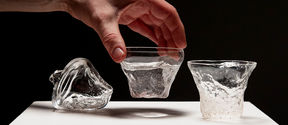
As unassuming as this tableware appears, it tells the stories of our disguised daily gestures.
ClaySkin is an experimental project that explores a biodegradable alternative to synthetic tattoo practice skin, commonly used by beginner tattoo artists.
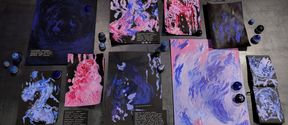
Porcelain, Acrylic on paper and wood, Poetry
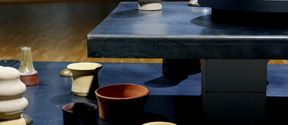
This interactive artifact represents my journey of personal exploration through wheel throwing.
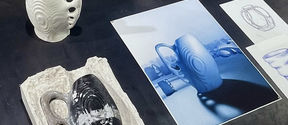
Exploring nature-inspired design.
By switching from an end result focused process, to a more playful iterative process, I give myself the freedom to make rough prototypes, play with the material while doing it and see where the exploration leads me.
Snow recognises the shape of the place where it piles up carefully and gradually. Snow accepts any shape. How can I recognise the shape of my thoughts and imagination like snow?
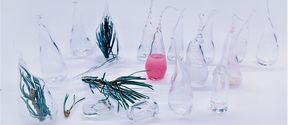
(Pronounce: Bai/Meaning: hollow)
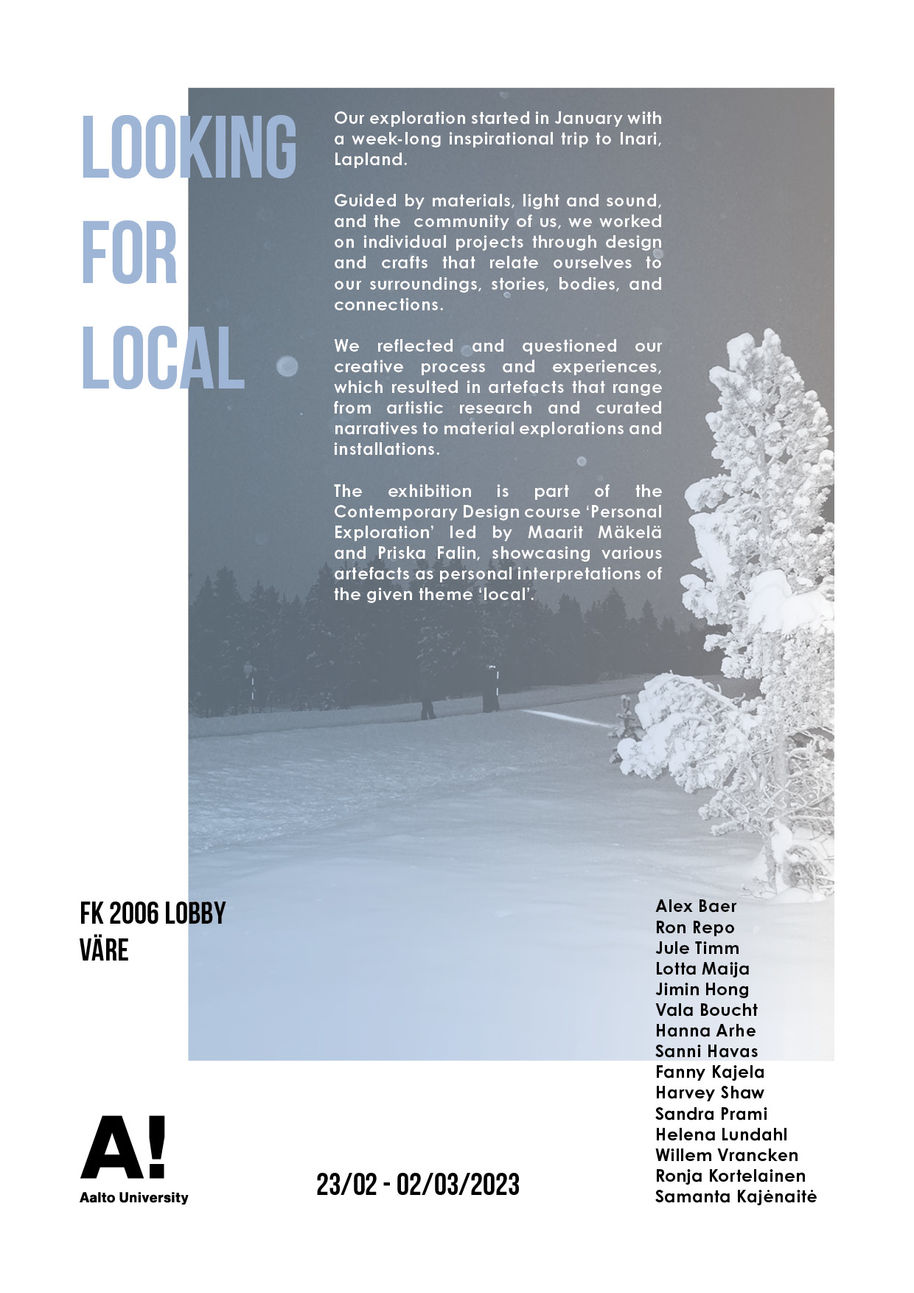
Our exploration started in January with a week-long inspirational trip to Inari, Lapland.
Guided by materials, light and sound, and the community of us, we worked on individual projects through design and crafts that relate ourselves to our surroundings, stories, bodies, and connections.
We reflected and questioned our creative process and experiences, which resulted in artefacts that range from artistic research and curated narratives to material explorations and installations.
The exhibition is part of the Contemporary Design course 'Personal Exploration' led by Maarit Mäkelä and Priska Falin, showcasing various artefacts as personal interpretations of the given theme 'local'.
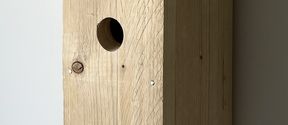
Spruce, wireless speaker
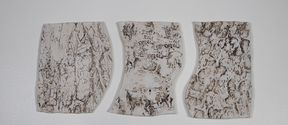
Ceramics
How are our ecosystems affected by the inconsistent snow blanket?
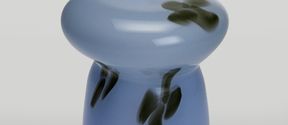
A portrait of me and my grandmother ‘Mummu’, who suddenly passed away during the Personal Exploration course.
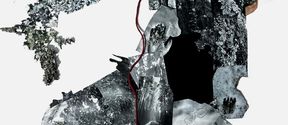
What is a body? Can it be separated or extended?
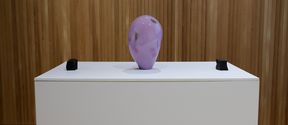
Finnish oak, mouth blown glass, microcontroller
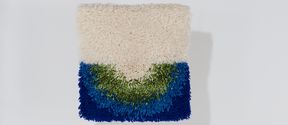
wool, mohair & synthetic blend yarns
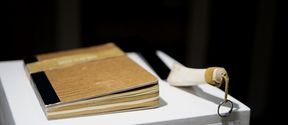
Materials: Reindeer bone, porcelain
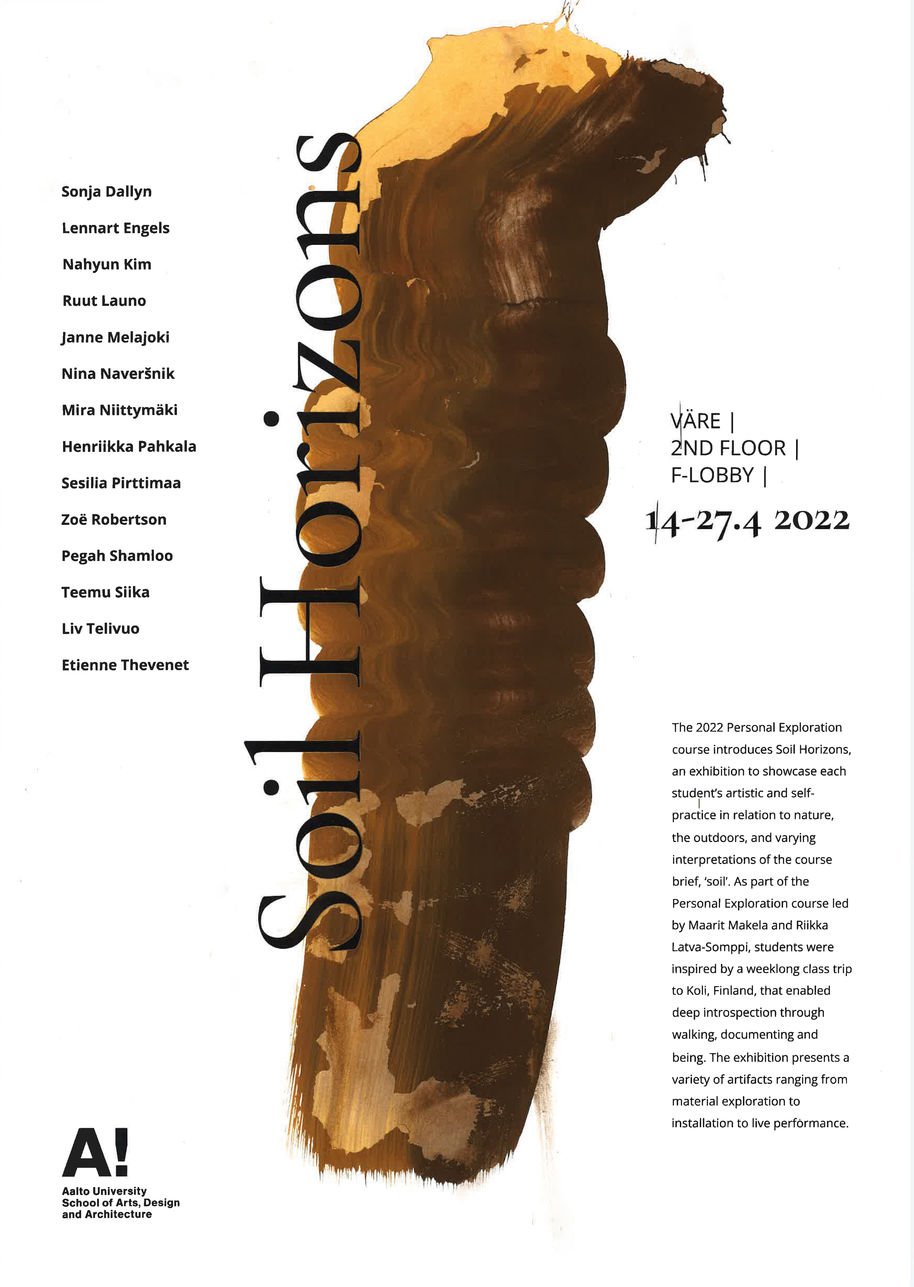
The 2022 edition of the flagship Contemporary Design course Personal Exploration started in March on a week-long inspirational trip to Koli. Through meditative walks in snowy forests, cross-country skiing and reflective writing, students learned to dive in their personal practice, find a connection to the theme of the course — soil — which was sometimes fantasized by the inability to dig through meters of snow. On the edge of recovery from the global pandemic and its social restrictions, the trip was also a moment for simply being.
Upon return to Helsinki, each individual was able to experiment a variety of processes around one’s metaphysical experience of soil, nature in general, and personal stories.
The Soil Horizons exhibition was introduced in April 2022 and showcased the variety of artifacts produced by the cohort, ranging from graphic expression, material exploration to installation and video-making.
Students: Sonja Dallyn, Lennart Engels, Nahyun Kim, Ruut Launo, Janne Melajoki, Nina Naveršnik, Mira Niittymäki, Henriikka Pahkala, Sesilia Pirttimaa, Zoë Robertson, Pegah Shamloo, Teemu Siika, Liv Telivuo, Etienne Thevenet.
Teachers: Riikka Latva-Somppi, Maarit Mäkelä.
Exhibition time: 14.4. - 27.4.2022
Venue: Väre building - Second Floor - F Lobby
Photographs by Anne Kinnunen, unless stated otherwise.
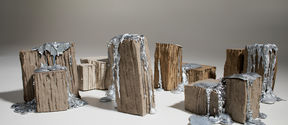
The emergence of latent images and forms through the manipulation of matter. Ghost Town is the thermal shock between ferrous and clay-based soils, both cracking and setting the other. The artwork aims to channel emotional frictions as generative force, by letting untold memories of childhood surface.
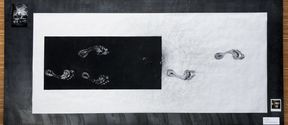
“Do we breathe or are we breathed? The sanskrit prana, “breathing forth,” refers to the source and force of life and the vibratory energy of all manifestation”
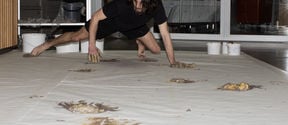
This video exhibits a performance in which Lennart Engels approaches rock climbing as an artistic practice to expose the underlying creative processes that occur in the act.
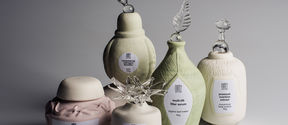
What if we treated soil as we treat our skin? After all, soil is the skin of the Earth, and our own skin is soil for billions of microbes. The project investigates ways to care for the degraded land and barren soil resulting from human actions. It also speculates on a future where soil care would be one of our daily routines. The work also satirically comments on the oversaturated field of beauty care products of our time when more than ever we should focus our care to more fundamental issues.
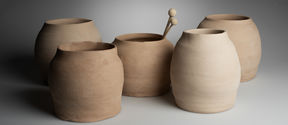
This is an instrument which is Jangdok-shaped, a traditional Korean jar that is buried in the soil to ripen Kimchi. The reason why the food made in Jangdok is delicious is that until just before it comes out to the world, they adapted to the environment in the soil and prepared to become delectable. When we play this instrument, the moment we have to focus is not the moment when the sound comes out, but the moment when we adapt to this space, focusing solely on the instrument and all thoughts disappear. Wait for silence and concentration in your mind like the soil does.
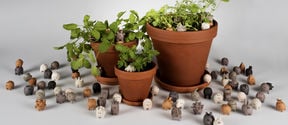
”Once upon a time, when magic was still strong in all parts of the world, a curious event took place every spring. As the snow began to melt, revealing the first plants, sometimes, if you were lucky, the soil beneath your feet would come to life. They called them Little Creatures. Some say they carry messages, and should you listen closely, a little creature might have one for you.”
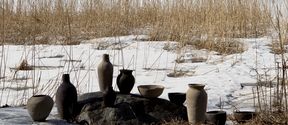
Death does not part us, it unites us. We all die eventually. Ten hand-built raw clay vases have been left in nature to fall apart, disintegrate and dissolve into the environment, symbolizing the death of loved ones. The vases have been photographed daily to reveal their decomposition. The artist has not had to face the death of a close relative and the resulting grief that is inevitably coming. With this artwork, she wants to prepare for it and address the topic she fears.
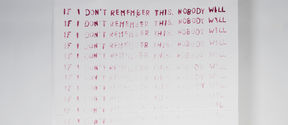
The act of remembering takes its toll: each recall creates distance from the initial event, a memory of the memory. If I Don’t Remember This, Nobody Will manifests the intangible: what does forgetting look like?
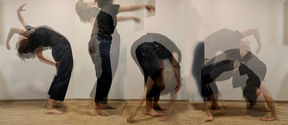
Documentation from artistic research
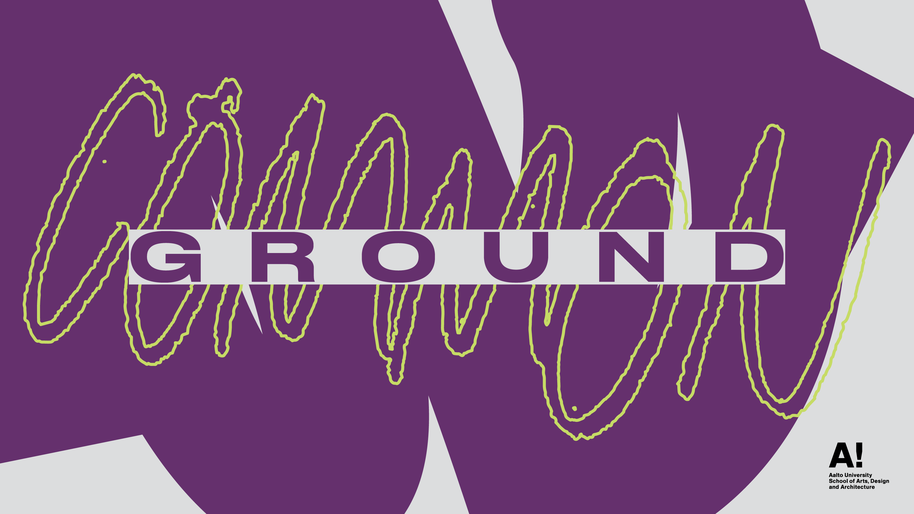
Common Ground is an exhibition that presents 11 projects made in the Contemporary Design programme’s ‘Personal Exploration’ course by Master Students from Aalto ARTS. The works were built around the given course theme ‘Ground’, which each student handled from their own perspective.
The starting point for the course was an excursion to Koli, Eastern Finland. The change of environment gave time and space to start the creative process and personal exploration. The course was postponed from Spring 2021 to Autumn 2021, giving a very different environment in Koli, shining in all the colors of the autumn time ‘ruska’. The course was also the first one held entirely in person in Aalto for the students who have done their studies during the pandemic.
Koli worked as an inspirational source for the works, where each student found things that excite, scare, interest or troubles them. Issues around the environmental crisis as well as more personal challenges were brought up. The shared experiences formed a strong common ground within the students. The exhibition pieces tackle these issues through their subjects, materials and techniques.
Common ground = an area of shared interests or opinions held by two or more people or groups. Explanation by Cambridge Dictionary.
Students: Alejandra Alarcón, Tiia von Becker, Antti Grundstén, Johannes Kaarakainen, Roosa Muukkonen, Maria Nurminen, Hannakaisa Pekkala, Taísa Ribeiro, Katrīna Šatalova, Turkka Taipale, Emilie Tuuminen
Teachers: Maarit Mäkelä, Bilge Aktaş
Exhibition time: 29.10.- 08.11.2021
Venue: Aalto University, Väre galleries V2 & Q109 Kipsari, Otaniementie 14
Text by Hannakaisa Pekkala & graphics by Antti Grundstén.
Photographs by Anne Kinnunen, unless stated otherwise.
Through an exercise of filtering and curating, Terra Cognita is a landscape composed of multiple fragments encountered while walking around different locations in Finland. The objects reflect on the mistaken idea of the intact landscape and the far from natural scenery that surrounds us.
Terra Incognita: (unknown land) is a term used in cartography for regions that have not been documented.
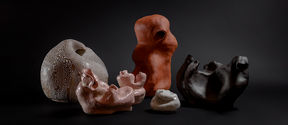
The work is a series of sculptures, that give a physical form to a variety of pessimistic inner voices stemming from deep within the subconscious. The beings feed on the feelings of fear, insecurity, frustration, self-doubt and uncertainty. They speak through their synthesized voices, craving for attention and validation, constantly reminding of their existence.
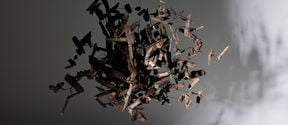
This work was a means to make sense of my own lived experience with a dissociative disorder. Along the way I found out that wholes are not necessarily ones, and that more important than unified fronts are the dialogues in-betweens. Sense of connection creates a sense of common ground, a safe space for change and growth.
The end result is “one” sculpture made of numerous separate parts, coming together to form a whole, held together by their connect.
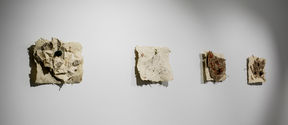
This work explores the moment of change. What happens when something comes to a point of its life cycle, where it ceases to be what it was? At that moment, old structures get dismantled and its substance splits into a countless number of particles. These particles then travel where they are taken to, and become a part of something else.
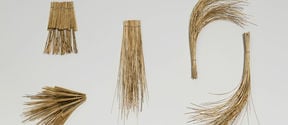
The hand-sewed surfaces explore the connection between making, crafts and creativity. Focusing on simple crafts can offer calmness, a way to be
grounded and present through repetitive work led by intuition and freedom. The outcome is a dialogue between the fragile, subtle material and the working hands.
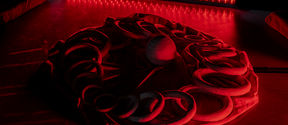
‘I have always been here’ is a ceramic and audio installation where women are invited to listen and connect to Mother Earth. The designer embodies the voice of the cosmos, summoning the sun and moon, the elements of nature and the cycle of life in one novel ancient ritual. The ceremony is set around ceramic rings centered by one sphere, that broadcasts the voice of the Earth.
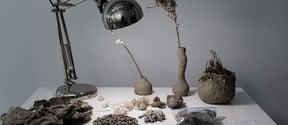
In my project I put focus on the process of interaction with material. I work without sketches or expectations of the final outcome. My intention is to experience a full cycle of clay, so I prepare it myself straight from the ground. The practice reflects anthropologist’s Tim Ingold’s theory on thinking through making.
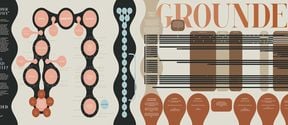
How to ground yourself? Instead of pushing forward, what if we would take a look back for a while? Could it help us to go forward? By looking at your personal journey it’s easier to see the growth. Rather than comparing yourself to others, take a look at the steps you have already taken. This is a tool to map yourself, to visualise your journey, to give more credit to yourself, to watch from the right perspective, to put things in perfect scale. To be grounded.
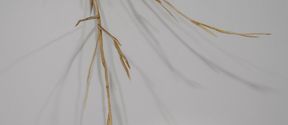
Ground is a state of mind. Homesick represents the processed feelings and mindscapes I went through on this personal journey. Being with the material and working with my hands acted as tools to find my way back to the missed comfort and serenity.
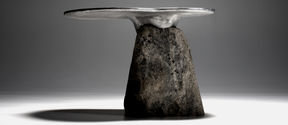
These materials that we excavate brutally from the earth frighten, excite and worry me simultaneously. We rarely stop to think the origins of metals we consider human made or synthetic.
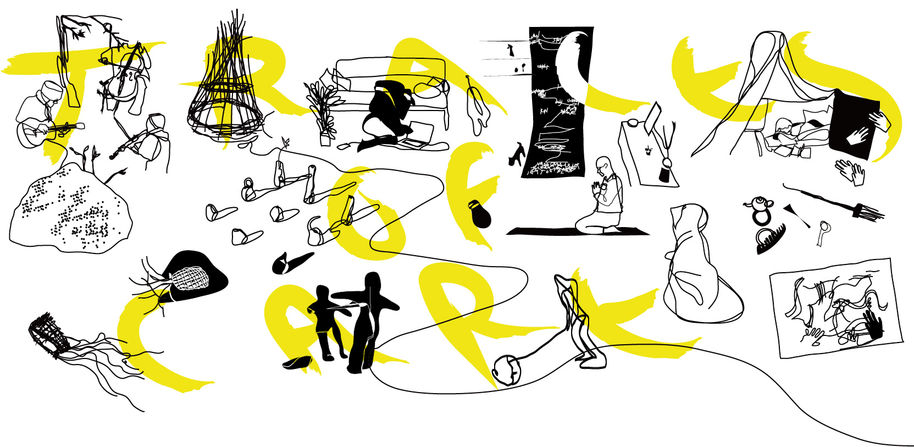
“Traces of Care” – Exhibition of the Personal Exploration course
Traces of Care is a virtual exhibition of 15 Master's students of the Aalto ARTS Contemporary Design program under the course Personal Exploration. The presented works were made using different techniques from various viewpoints under the subject of care.
We started off with an inspirational trip to Koli in March 2020. During these five days students did quick-and-dirty exercises, had discussions, heard lectures and wrote diary reflections around the theme ’care’. The most memorable experiences for the group were witnessing the winter during a year when thermic winter did not arrive to Helsinki at all, enjoying the silence of the nature as well as the calm atmosphere among peer students, and playing with our companion dog Cookie. Care was present all the time: in baking Karelian pies to go with evening tea and rolling-in-the-snows together during the sauna.
When we arrived back to Helsinki, absurd times were ahead. The Covid-19 pandemic affected everyone’s lives in general, and the content of our course changed radically. The contrast of the carefree trip from Koli to the middle of the corona-panic was huge. The situation forced us to work from our homes without the use of our studios in Aalto. Needless to say, this affected the final work we chose to make. Many of us shifted from our material-oriented ideas to completely new mediums. However, our theme, care, was still visible all the time, as we cared about other beings by isolating ourselves inside our homes.
All of us were affected by our trip to Koli and its landscape, and many chose to explore the relationship between humans and non-humans in our final work. Some of the key questions were how can we take care of nature in return when it gives so much to us, and what kinds of traces do we leave from our care?
Another central theme was identity, and how it related to our theme of care. Questions of security and protection also arose from the current situation of the world, and many were thinking about the fragility of humankind in the face of disaster. How can we shelter ourselves from these events and what are the things we hold dear?
Students:
Chen Tzuyu, Guridi Sotomayor Sofia, Henttu Sini, Kilpi Linnea, Latva-Somppi Aura, Levander Joel, Luhtasela Salla, Lötjönen Miia, Niemelä Iines, Nieminen Sirena, Purasachit Irene, Rinne Julius, Shenyer Jenna, Strand Julia, Virasjoki Vertti
Teachers:
Krista Kosonen and Maarit Mäkelä
Venue:
World Wide Web
Text by students
Posted on April 2020
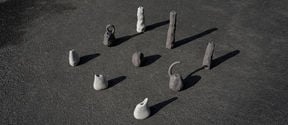
Forms of Care is a collection of care in the form of vases. In contrast to human-centric design, these pieces are formed by having flowers in the centre of the making. As the flowers continue growing, their postures are constantly changing. The same vase they were comfortable in yesterday might not be the right one tomorrow. By observing and caring for the same tulip, alstroemeria and freesia throughout the course of two weeks, the eight vases in the collection were made in dialogue with the flowers, responding to their needs for support in each stage.
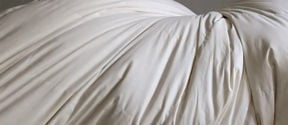
When a caterpillar coils a silky covering over itself it surrenders to a process of breaking apart and arising as a new beautiful being. The current situation of the world has forced us to curl up into our own cocoons and question our ways of living. So how about us humans? Are we willing to transform?
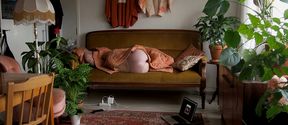
"I'm always happiest alone" reflects on loneliness in a society that pressures us into sociality. Everyone feels an individual need for loneliness and each of us is alone in a different way. The desire to be alone is also a privilege that can be safely felt, when social networks and relationships are plentiful and healthy. It’s easy to want to be alone, when you don’t feel lonely.
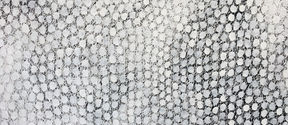
It clears the sea by eating plankton but it is not native to our ecosystem and causes harm by attaching to any surface. What is left from it is the small round traces and beautiful details.
It is not always clear what is best for nature, but most important is that we care for and pay attention also to the smallest details of the world.
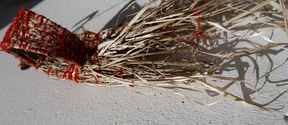
This video explores the intertwined relationship between human and non-human forces involved in a conceptual care network. Red threads are used to point out three different concepts that co-exist within this entangled relational web; its unforeseen forces, its tension of co-dependence, and its convergence that interweaves the living and non-living into other forms of being. By following these threads and forces, I want to express care as relational thinking. If our lives are tangling with many other forces, how would it affect the way we care for many non-human others?
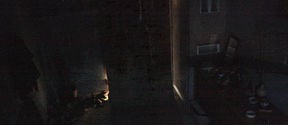
This is a manifesto for myself, to be presented in my own room with the dust and hair lying in the corners, next to my messy bed and piles of clothes, letters and drawings, with the houseplants and fruit-peels and the smell of my biodegradable. It is not still or silent; there is light reflecting from a window of a neighbour house, the shadows of trees of the nearby forest and the sounds of buses and dogs and bicycle bells skipping around the neighbourhood. This manifesto is born from within myself but also from the outside, readings and discussions and perceptions, and it is to be presented and projected from and to all these directions.
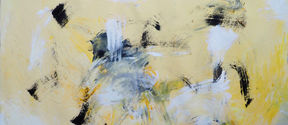
‘Place to be’ is an experimental painting process, in which the journey is more important than the final artefact. The main thing was to paint mostly blindfolded, to get deeper in touch with paper and paint to forget rationalisation and overthinking. I mind-travelled to the places and freedom of my childhood to let go of the stress and control of adult-me.
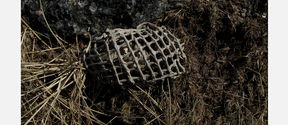
'Weight lifting' is an ongoing process between human and nature and the weight we put on the land. By walking through memorable islands, finding objects of affection that don't belong to the landscape, and doing an exchange between the land.
I've taken the objects back where they belong, replaced their form in unfired clay and left it for the land to absorb in its natural way. In this process the land gives me an opportunity to ground myself, to study and enjoy everything it has to offer, and in exchange I thank the ground by helping it recover from the trash that doesn't belong there.
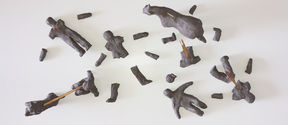
Earthly bonds is a series of sculptural vignettes studying relational dynamics and the complexity of care. Each scene depicts a relationship inevitably compromised by notions such as power, trust, and dependency. Their varying stages of decomposition question if and how the relationships function without tension holding them together. Who is dependent on whom?
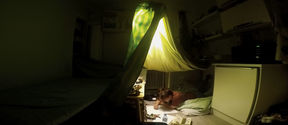
“Maja” in Finnish means “shelter” or “blanket fort.” A shelter is a place to feel safety and care.
In my project I wanted to fulfill a childhood dream of living in a self-made fort. I built a blanket fort in my apartment from materials I already owned and spent a week there taking care of myself, by doing things I have not had time to do in a long time. Maja offered me a safe place to be relaxed, creative and playful.
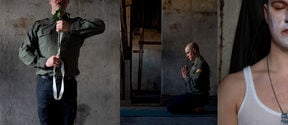
We at war.
We at war with racism, sexism, but most of all we at war with ourselves. In this complex situation the enemy is invisible and the weapons we use are not made of steel.
Through exploration into the past environments, emotional atmospheres and cultures I’ve lived in I’ve tried to make sense of how they have shaped me as a person and how to accept the fact that it has not always changed me for the better.
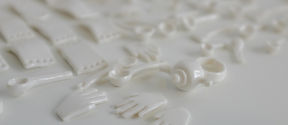
Our days are full of silent care. Care for others expressed through small gestures and actions like combing a child`s hair or cooking for the family, which are accompanied by objects normally considered trivial. This collection explores the beauty of these everyday objects and the relevance of this invisible care that is usually taken for granted, but that is so fundamental for everyone's wellbeing. Through the repetition of small hand made porcelain items, jewelry pieces are created to show the value of these marginalized actions usually asociated with feminine care, while being in contact with our bodies.
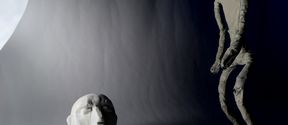
Crown of Thoughts is animated short film made with stop motion technique. It follows a figure created from various materials and its encounter with a humanlike head. Through a coalescence, the head changes the figures perception of time and their surroundings.
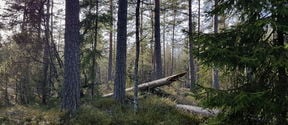
"As we humans are big beneficiaries in our relationship with nature, my goal was to give something back in return. I wanted to use music to help the spring forest grow. Studies have shown that music affects the growth of plants as it is enjoyed by humans in general. Could we use music as a way to re-connect and coexist with nature?
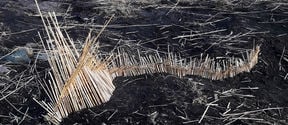
Twig Lady is a series of ongoing works executed outdoors as a way of taking care of myself through the repetitive and meditative action of making by hand. Working with new materials, mainly twigs and reeds, forced me to really get in tune with them, feel their will in my fingertips, and forget my own designerly ambitions - and just have fun.
Nature of Process is a multi-material exhibition that presents works made using different techniques from various viewpoints under the subject of nature. The works present the ways in which we understand and interact with nature. Our interpretations are affected by our own experiences and cultural backgrounds. The students made a study excursion to Posio, Lapland. In Posio they spent time in nature and started their personal processes. The working method based strongly on self-reflection and critical thinking, both in written and discussed forms. Materials and their natural features were a crucial part of the course subject as we started our journey with the material experiments.
Course Personal Exploration March 2019
Teachers: Gianluca Giabardo, Krista Kosonen and Maarit Mäkelä
Exhibition: Nature of Process 11.04.-19.04.2019 at Harald Herlin Learning Centre
“Work and Contribution” shares series of personal explorations and expressions of students about “labour”. During the past seven weeks they have observed and reflected on what supported their individual and collective labour, asked and been asked difficult questions, disrupted their patterns and redefined them. They have come together in classrooms, living rooms, dining rooms and saunas to have conversations about what they do, how and why they do it. The contributions offered by these moments of sharing, and the following reflection have resulted in a series of work(s): from textile to performance, drawing to installation which are traces of their labour.
Course Personal Exploration March 2018
Teachers: Maarit Mäkelä, Bilge Aktaş
Exhibition: “Work and Contribution” in Beta Space between 12–23 April 2018
‘Matter’ students approached the meaning of the concept of matter. The first part of the course was an inspirational week in the Museum Estate of Hevossilta in Forssa and in Nuutajärvi glass village, where a group of 10 students collaborated with professional glassblowers. This experimental workshop challenged the students to invent and test their own tools while experiencing hot glass work. This two days of experimenting with all kinds of materials as tools brought inspiration, new experiences and very interesting results. What is now captured inside of the presented glass objects are the experiences that students shared in exposing themselves in the way of working with no clear understanding of the outcomes or the actions that the tools might perform when introduced to hot glass. This way of working set the ground for the personal paths that each student took during this course.
Teachers: Maarit Mäkelä and Priska Falin
Glass blowers: Alma Jantunen, Janne Rahunen, Matti Vilppula and Manuel Diemer
Tutors in the Glass Workshop: Maarit Mäkelä, Priska Falin and Anna Van der Lei
Professor Maarit Mäkelä is passionate about her work; hands deep in clay.
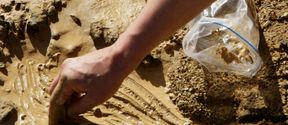
Finnish ceramic artists visualise land contamination in Venice research pavilion.
Empirica. Aalto University Research Group on Art, Design and Culture
"The Empirica group approaches research with an attitude, where making, acting and engaging play important roles".
“Nature of Process” – Exhibition of the Personal Exploration course
Empirica Updates. January 2020
“Work and Contribution” – Exhibition of the Design Exploration and Experimentation course
Empirica Updates. May 2018
Exhibition ‘Matter’, results of the Design Exploration and Experimentation course
Empirica Updates. June 2017